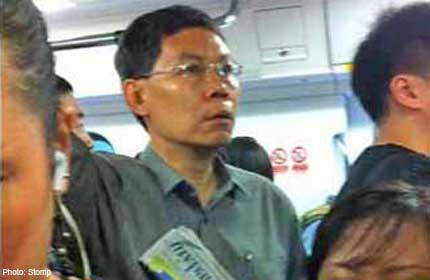- Joined
- Aug 29, 2008
- Messages
- 27,380
- Points
- 113
Hong Kong: High frequency of trains, larger capacity than S'pore
The train systems in Hong Kong and Taipei have been often cited as good examples of efficiency in moving people in crowded cities. Royston Sim visits both cities to find out what makes these systems successful.

PACKED TO THE BRIM: Commuters inside an MTR train during the morning peak hour. With its increasing ridership, the MTR, like Singapore’s MRT, has had to tackle overcrowding. -- ST PHOTO: ROYSTON SIM
It is 5.45pm on a weekday at Admiralty, an interchange station for the Island and Tsuen Wan lines on Hong Kong's MTR - its version of Singapore's MRT.
Throngs of commuters are rushing across the platform to transfer from one train to another at the station, which is located near the Central Business District.
Crowds build up quickly at the platform, and it gets at least as crowded as the Jurong East MRT station does during rush hour. Every train is packed to the brim. But turnover is quick.
Trains arrive at intervals of just over a minute. Each MTR train, with eight carriages compared to six in Singapore, can also carry more passengers. And there is a staff member at every door to help in crowd control.
[TABLE="class: grid, width: 500"]
<tbody>[TR]
[TD][/TD]
[TD="align: center"]HONG KONG MTR[/TD]
[TD="align: center"]SINGAPORE MRT (NSEWL, CCL, NEL)*[/TD]
[TD="align: center"]TAIPEI METRO[/TD]
[/TR]
[TR]
[TD]Year opened
[/TD]
[TD]
[TD]
[TD]
[/TR]
[TR]
[TD]Route length (km)[/TD]
[TD]
[TD]
[TD]
[/TD]
[/TR]
[TR]
[TD]Number of rail lines[/TD]
[TD]
[TD="align: center"]4[/TD]
[TD="align: center"]10[/TD]
[/TR]
[TR]
[TD]Stations[/TD]
[TD="align: center"]84[/TD]
[TD="align: center"]99[/TD]
[TD="align: center"]104[/TD]
[/TR]
[TR]
[TD]Train design[/TD]
[TD]8 carriages, 5 doors per carriage
(12 carriages for the East Rail Line
to Shenzhen, China)[/TD]
[TD]6 carriages, 4 doors per carriage
(3 carriages for the Circle Line)[/TD]
[TD]6 carriages, 4 doors per carriage
(4 carriages for the medium-capacity
Wenhu Line)[/TD]
[/TR]
[TR]
[TD]Average daily
ridership (million)[/TD]
[TD="align: center"]4.18[/TD]
[TD="align: center"]2.65[/TD]
[TD="align: center"]1.65[/TD]
[/TR]
[TR]
[TD]Passenger loading
during peak hours[/TD]
[TD="align: center"]4 to 5 passengers per sq m[/TD]
[TD="align: center"]4 to 5 passengers per sq m[/TD]
[TD="align: center"]4.35 passengers per sq m[/TD]
[/TR]
[TR]
[TD]Average peak frequency[/TD]
[TD="align: center"]90sec to 4min[/TD]
[TD="align: center"]2min to 3min[/TD]
[TD="align: center"]2min 15sec to 4min 40sec[/TD]
[/TR]
[TR]
[TD]Average non-peak
frequency[/TD]
[TD="align: center"]3min to 14min[/TD]
[TD="align: center"]4min to 7min[/TD]
[TD="align: center"]3min 35sec to 5min 46sec[/TD]
[/TR]
</tbody>[/TABLE]
The train systems in Hong Kong and Taipei have been often cited as good examples of efficiency in moving people in crowded cities. Royston Sim visits both cities to find out what makes these systems successful.
Published on Apr 29, 2013
8:14 AM
PACKED TO THE BRIM: Commuters inside an MTR train during the morning peak hour. With its increasing ridership, the MTR, like Singapore’s MRT, has had to tackle overcrowding. -- ST PHOTO: ROYSTON SIM
It is 5.45pm on a weekday at Admiralty, an interchange station for the Island and Tsuen Wan lines on Hong Kong's MTR - its version of Singapore's MRT.
Throngs of commuters are rushing across the platform to transfer from one train to another at the station, which is located near the Central Business District.
Crowds build up quickly at the platform, and it gets at least as crowded as the Jurong East MRT station does during rush hour. Every train is packed to the brim. But turnover is quick.
Trains arrive at intervals of just over a minute. Each MTR train, with eight carriages compared to six in Singapore, can also carry more passengers. And there is a staff member at every door to help in crowd control.
[TABLE="class: grid, width: 500"]
<tbody>[TR]
[TD][/TD]
[TD="align: center"]HONG KONG MTR[/TD]
[TD="align: center"]SINGAPORE MRT (NSEWL, CCL, NEL)*[/TD]
[TD="align: center"]TAIPEI METRO[/TD]
[/TR]
[TR]
[TD]Year opened
[/TD]
[TD]
1979
[/TD][TD]
1987
[/TD][TD]
1996
[/TD][/TR]
[TR]
[TD]Route length (km)[/TD]
[TD]
182
[/TD][TD]
148.9
[/TD]
[TD]
112.8
[/TD]
[/TR]
[TR]
[TD]Number of rail lines[/TD]
[TD]
10
[/TD]
[TD="align: center"]4[/TD]
[TD="align: center"]10[/TD]
[/TR]
[TR]
[TD]Stations[/TD]
[TD="align: center"]84[/TD]
[TD="align: center"]99[/TD]
[TD="align: center"]104[/TD]
[/TR]
[TR]
[TD]Train design[/TD]
[TD]8 carriages, 5 doors per carriage
(12 carriages for the East Rail Line
to Shenzhen, China)[/TD]
[TD]6 carriages, 4 doors per carriage
(3 carriages for the Circle Line)[/TD]
[TD]6 carriages, 4 doors per carriage
(4 carriages for the medium-capacity
Wenhu Line)[/TD]
[/TR]
[TR]
[TD]Average daily
ridership (million)[/TD]
[TD="align: center"]4.18[/TD]
[TD="align: center"]2.65[/TD]
[TD="align: center"]1.65[/TD]
[/TR]
[TR]
[TD]Passenger loading
during peak hours[/TD]
[TD="align: center"]4 to 5 passengers per sq m[/TD]
[TD="align: center"]4 to 5 passengers per sq m[/TD]
[TD="align: center"]4.35 passengers per sq m[/TD]
[/TR]
[TR]
[TD]Average peak frequency[/TD]
[TD="align: center"]90sec to 4min[/TD]
[TD="align: center"]2min to 3min[/TD]
[TD="align: center"]2min 15sec to 4min 40sec[/TD]
[/TR]
[TR]
[TD]Average non-peak
frequency[/TD]
[TD="align: center"]3min to 14min[/TD]
[TD="align: center"]4min to 7min[/TD]
[TD="align: center"]3min 35sec to 5min 46sec[/TD]
[/TR]
</tbody>[/TABLE]






